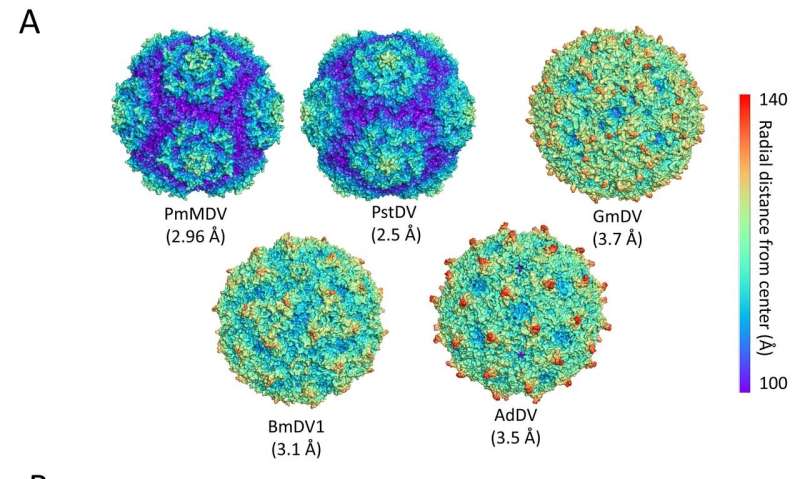A new strategy of cell entry for some types of parvoviruses

Researchers at the Institut national de la recherche scientifique (INRS), in collaboration with American scientists, have discovered a new parvovirus strategy for reaching the cell nucleus, where they reproduce. The results were published in the journal Proceedings of the National Academy of Sciences.
This new method of entry is a good example of host-driven evolution. The parvoviruses are extremely contagious and persistent in the environment. They are transmitted mainly through the feces of infected invertebrates, vertebrates and mammals including humans. To reach the nucleus of host cells, parvoviruses use mostly enzymatic reactions. They are first absorbed by the cell inside a vesicle, a membrane compartment. To escape, parvoviruses activate a viral enzyme domain called phospholipase A2 (PLA2), a key mechanism discovered in 2001 by the same INRS laboratory.
However, some types of parvoviruses, as well as other nonenveloped viruses, do not have this enzyme domain and must therefore escape from the vesicle by some other means. Using molecular biology and structural studies, INRS researchers have discovered that a new virus targeting the giant tiger shrimp uses a more mechanical response. This type of parvovirus contains an inner pentamer helix bundle held together by calcium ions. When the microorganism is in the vesicle, where the calcium concentration is decreased by the elimination of toxic substances, the bundle is released and opens up the protein shell (capsid) enclosing its genetic material and the membrane, allowing viral DNA to escape into the nucleus for replication.
"It turns out the incorporation of a PLA2 enzymatic domain is only one strategy, even as far as the family of parvoviruses is concerned. Here, we show yet another strategy that may not be limited to one parvovirus lineage, but to other economically important parvoviruses, such as parvoviruses of domestic fowl and farmed mink," says Judit Pénzes, a former postdoctoral fellow at INRS and first author of the paper published on August 18, 2020.
Host-Driven Evolution
INRS Professor Emeritus Peter Tijssen, lead author of the publication, also discusses the host-driven convergent evolution of this method of entry into the cell. "Two parvoviruses with different DNA sequences, which both target shrimp, have adopted similar strategies for reaching the nucleus," he says.
Using a microscope nearly two stories high, the FEI Titan Krios, Judit Pénzes was able to solve the complete structure of the virus on a near-atomic scale. "You could already feel the energy rumbling through the enormous machine upon entering the facility. I think that it's probably the same to what scientists involved in space exploration must have felt when they saw a rocket ready to lift off for the first time," says the postdoctoral student.
Eventually, the discovery of this mechanism could lead to a better understanding of how viruses enter cells and even to a cure. "If we know how the parvovirus manages to release its DNA into the nucleus of the host cell, we can try to find a molecule to block this action," concludes Professor Tijssen. The collaboration with the Florida-based research team will allow them to deepen the knowledge on this subject and possibly find other methods of entry that are yet unknown.
More information: Judit J. Pénzes et al, Molecular biology and structure of a novel penaeid shrimp densovirus elucidate convergent parvoviral host capsid evolution, Proceedings of the National Academy of Sciences (2020). DOI: 10.1073/pnas.2008191117
Journal information: Proceedings of the National Academy of Sciences
Provided by Institut national de la recherche scientifique - INRS


















